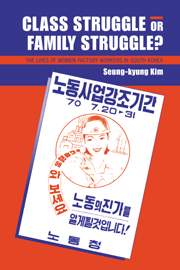Book contents
- Frontmatter
- Contents
- List of Tables and Figures
- Preface: Field, Subject, Author
- Acknowledgments
- Language Note
- 1 Women Caught between Global Capitalism and South Korean Patriarchy
- 2 The Process of Production in the Masan Free Export Zone
- 3 The Myth of Social Mobility: Its Creation and Reproduction among Women Workers
- 4 Labor Militancy and Collective Action
- 5 The Making of Working-Class Identity: Students' Theories and Workers' Lives
- 6 Conclusion
- References
- Index
5 - The Making of Working-Class Identity: Students' Theories and Workers' Lives
Published online by Cambridge University Press: 02 December 2009
- Frontmatter
- Contents
- List of Tables and Figures
- Preface: Field, Subject, Author
- Acknowledgments
- Language Note
- 1 Women Caught between Global Capitalism and South Korean Patriarchy
- 2 The Process of Production in the Masan Free Export Zone
- 3 The Myth of Social Mobility: Its Creation and Reproduction among Women Workers
- 4 Labor Militancy and Collective Action
- 5 The Making of Working-Class Identity: Students' Theories and Workers' Lives
- 6 Conclusion
- References
- Index
Summary
The rapidity with which the South Korean working class emerged as a self-aware political force is one of the remarkable aspects of recent Korean history. During the past few decades, as industrial workers have increased in number, they have come to participate in political activity on a nationwide scale and show growing signs of class consciousness. As Koo observes, “In the 1950s or even in the 1960s, one rarely heard people talking about social classes in Korea” (1993:131). By the 1970s this situation had begun to change, and during the 1980s the working class emerged as the country's “most visible class force” (ibid.: 132). In this chapter, I examine some of the key ideological and cultural forces that contributed to its developing consciousness and show how workers in Masan fit themselves into this working class.
Class, as Thompson argues, has to be understood as “a social and cultural formation” (1966:11), “a relationship and not a thing” that “happens when some men [sic], as a result of common experiences (inherited or shared), feel and articulate the identity of their interests as between themselves, and as against other men whose interests are different from (and usually opposed to) theirs” (ibid.:9). In South Korea, a politically aware working class developed with extraordinary rapidity, because rapid industrialization created the necessary community of people with shared interests but also because a repressive state drove its intellectual opposition into the workers' movement. The presence of intellectuals allowed workers to develop sophisticated and coordinated political action, which otherwise might not have been possible in a workforce composed mostly of relocated peasant farmers. Ironically, working-class militance resulted directly from repressive government policies.
- Type
- Chapter
- Information
- Class Struggle or Family Struggle?The Lives of Women Factory Workers in South Korea, pp. 129 - 169Publisher: Cambridge University PressPrint publication year: 1997



